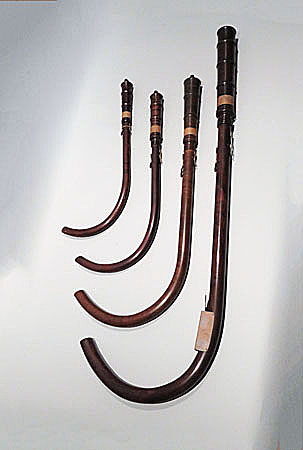
Owner: HWMC
Catalog#: 2CL-AERV-24; 2CL-AERV-25; 2CL-AERV-26; 2CL-AERV-27
Double Reeds - Crumhorns
Moeck Steinkopf ‘Renaissance Crumhorn Set'
Lower Saxony, Germany
Moeck Steinkopf
Wood, brass
ca. 1960’s
Length of Soprano: Full length: 19 in
Length of Alto: Full length: 23.5 in
Length of Tenor: Full length: 29 in
Length of Bass: Full length: 42 in
Wind Instruments – Woodwind Instruments – Double Reeds – Crumhorns
Engraved on top section: “Moeck Steinkopf”
The crumhorn is a double-reed wind-cap instrument with a cylindrical bore and a curved lower end to the body. To play, the musician blows into the protective reed cap causing the enclosed double-reeds to vibrate. The name crumhorn comes from the German “krumhorn” meaning “bent horn,” and relates to the old English term meaning curve. The crumhorn flourished between the 1400 to about 1650 C.E. Crumhorns encompass the range of a ninth and are usually played in a consort (ensemble) of instruments. They vary in size and pitch ranging from the great bass to sopranino and their use ranged from dances and madrigals to church music.
Shown here is a replica set of the Renaissance crumhorns, made by Moeck & Steinkopf. This set is made from a dark stained wood and each are embossed at the top for decoration.
The soprano crumhorn has seven front finger holes and one back thumb hole as well as two metal keys – one on the front and one on the back.
The alto crumhorn also has two square keys with seven finger holes and a thumb hole.
The tenor crumhorn has two square keys, the front one much larger than the other, seven finger holes, and a thumb hole.
The bass crumhorn has two square keys near the top, six finger holes, a thumb hole, and a forked key near the bottom with a decorative bracket for support.
In the 1930’s, the Moeck company was started in Celle, in Lower Saxony, Germany, by Hermann Moeck, Sr. His focus was on the production of recorders. As a result of increasing interest during the 20th century, in historical performance on reconstructed wind instruments from the Baroque and Renaissance eras (initiated by Otto Steinkopf), they began to research historical wind instruments including crumhorns, cornamuses, (Kortholte), shawns and pommers, dulcians, racketts, historical cornets, Renaissance and Baroque flutes, oboes, bassoons and early clarinets. By the 1960’s, the production of high-quality copies of selected museum instruments began. Nevertheless, few were made based upon demand. The development of the simple recorder to a more sophisticated instrument was and continues to be their focus today.
Reference: “Crumhorn.” Barra R. Boydell/R. “The Grove Dictionary of Musical Instruments,” 2nd ed., Vol 1., Laurench Libin, Editor in Chief. Oxford University Press, 2014.
